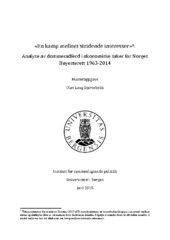| dc.description.abstract | The purpose of this thesis is to examine how case-level factors influence judicial behavior in civil economic cases on the Norwegian Supreme Court. While much is known about how justices' individual characteristics influence their voting, we know less about how the case level, i.e. law and legal procedure, affect judicial behavior. Therefore, the research question is: which case-level factors explain the justices' decisions in economic cases on the Supreme Court between a public and a private party in the period 1963-2014? Explanatory case-level variables, derived from relevant theoretical perspectives, are measured, coded and integrated into a comprehensive case-level model and supplemented by variables drawn from the collegial panel model, attitudinal model and personal attribute model. A logistic multi-level analysis that simultaneously measure forces at case, panel and individual levels is employed. All 804 unanimous and non-unanimous economic decisions in five-justice panels in the 1963-2014 period are analyzed, amounting to 4020 justice votes. The case-level data that I have coded for this thesis has been integrated with data drawn from the Database for Judicial Behavior in the Norwegian Supreme Court (Doranoh). All levels contribute to the model's explanatory power. (1) At the case-level, the results demonstrate that the justices are more inclined to vote in favor of the party that won both in the District Court and Court of Appeals, but inclined to vote against the party that lost in both. Initial analysis confirmed the legal wisdom that plaintiffs are likely to lose on the Supreme Court. But surprisingly, and the main empirical contribution of my analysis, when the Ministry of Finance is the plaintiff, the justices are much more inclined to vote in favor of the public party. (2) At the panel level, the analysis confirms that when female justices are in majority, all justices on the panel are inclined to vote for the private party. (3) At the individual level, interim justices and justices with experience from the Prosecutor General's office are inclined to vote for the public party, while former law professors are inclined to vote for the private party. There is no effect of appointing government on the justices' votes. Law and legal procedure matter. The results show that whom the public party is represented by is important. My findings identified plausible and nonobjective patterns that are likely to exist in a legal system where appointed justices apply their best legal understanding to resolve indeterminate cases. Further research is needed on the third branch of government. | en_US |
